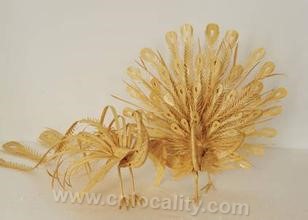welcomeSpecialty Foods Products!

Using old palm leaves and palm leaf cores as raw materials, children's toys were made after processing. The method is as follows: firstly, the collected palm leaves are folded according to the grain, tied tightly, and then put into a boiling water pot to cook until they turn from green to yellow and mature. Then exposed to the sun at night, completely dried and turned white, so that it is not deformed after production and can be stored for more than ten years. This kind of brown plait often uses the method of tying the knot to form an image. The main themes are dragonflies, grasshoppers, frogs, shrimps, centipedes, turtles, snakes, goldfish, chickens, cranes, peacocks and phoenixes. There are "single belly" and "double belly". After editing, make some small embellishments with attachments, such as using Yuanyang beans (red beans) as eyes, which is called "finishing touch". Snake eyes use bean meat, dragonflies use bean shells, shrimps use whole bean grains, and small animals' bodies and claws use thin wire as skeletons. According to Yi Zhengwen, a famous late brown weaving artist in Changsha, as early as War of Resistance against Japanese Aggression's time, people in Changsha used brown leaves to weave dragonflies, grasshoppers and other insects and sold them in the streets. This kind of situation can still be seen in the streets of Chongqing, Hankou, Nanjing, Shanghai and other cities. Those birds and insects strung with brown silk are green in yellow, fresh and simple, trembling slightly in the hands of artists, as if they were alive, attracting children and passers-by to stop and watch from afar. Brown weaving technology has risen to a folk art with a short history. In 1930s, Hunan folk artist Yi Zhengwen studied the skill of brown knitting, and then commodity production began to appear, and the varieties and skills of brown knitting developed. Yi Zhengwen has a strong interest in brown weaving. According to legend, in addition to seriously learning other people's techniques, he often crouches under the grass tree, observes the living habits of insects and animals, foraging, fighting and other activities, and studies hard. The varieties of grasshoppers and mantises are sold in various markets, which are quite popular and are known as "Hunan Comprehensive Weaving Easy". This may be the "originator" of brown plaiting with written records. Even now, there are very few people who engage in brown weaving. There are 18 China artists in Hunan, 12 of whom are Xiang embroidery masters, and Wang Wending is the only one who makes comprehensive editing. Wang Wending, born in Hunan Province in 1952, is the fifth master of arts and crafts in China. In 1994, his work "Comprehensive Compilation" was selected as an exhibition of folk art in China sponsored by the Ministry of Culture.
Reprinted with attribution:
https://cnlocality.com/(Chinese Specialty Products)
other
consult:(+86)13225231905